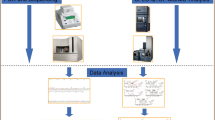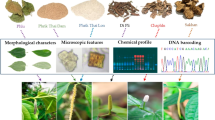Abstract
The tuberous roots of Pueraria candollei Grah. ex Benth. (Fabaceae), commonly known as white Kwao Krua, are used to relieve menopausal symptoms in Thai traditional medicine because they contain phytoestrogens. Black and red Kwao Krua crude drugs exist as well, but they have different botanical origins and pharmacological activities. There is a high demand for white Kwao Krua products, but because of the limited availability of the plant material, it is suspected that the adulteration and misidentification of white Kwao Krua crude drugs and products occur. In this study, we authenticated white Kwao Krua products collected from Thai herbal markets by molecular, chemical, and microscopic analyses. The nucleotide sequences in the internal transcribed spacer (ITS) and trnH–psbA regions of 23 samples of authentic P. candollei were analyzed, and both regions were found to have intraspecific DNA polymorphisms. Based on the single nucleotide polymorphisms in the ITS1 region, species-specific primer sets of P. candollei were designed to authenticate white Kwao Krua and differentiate it from red and black Kwao Krua. Only the PCR products of KWP02 were not amplified by the primer sets. Isoflavonoid contents and microscopic features were used to support the results of molecular analysis to clarify the botanical origin of white Kwao Krua. Molecular, chemical and microscopic methods confirmed that all the Thai Kwao Krua products examined in this study contained authentic “white Kwao Krua” as claimed on their labels.






Similar content being viewed by others
References
Sookvanichsilp N, Soonthorncharoennon N, Boonleang C (2008) Estrogenic activity of the dicholoromethane extract from Pueraria mirifica. Fitoterapia 79(7–8):509–514
Yagi N, Nakahashi H, Kobayashi T, Miyazawa M (2013) Characteristic chemical components of the essential oil from white kwao krua (Pueraria mirifica). J Oleo Sci 62(3):175–179
Udomsuk L, Jarukamjorn K, Tanaka H, Putalun W (2009) Production of isoflavonoids in callus cultures of Pueraria candollei var. mirifica. Z Naturforsch C 64(3–4):239–243
Kongkaew C, Scholfield NC, Dhippayom T, Dilokthornsakul P, Saokaew S, Chaiyakunapruk N (2018) Efficacy and Safety of Pueraria candollei var. mirifica (Airy Shaw & Suvat.) Niyomdham for menupausal woman: a systematic review of clinical trials and the way forward. J Ethnopharmacol 216:162–174
Wiriyakarun S, Yodpedch W, Komatsu K, Zhu S, Ruangrungsi N, Sukrong S (2012) Discrimination of the Thai rejuvenating herbs Pueraria candollei (White Kwao Khruea), Butea superba (Red Kwao Khruea), and Mucuna collettii (Black Kwao Khruea) using PCR-RFLP. J Nat Med 67(3):562–570
Maruyama T, Kawamura M, Kikura-Hanajiri R, Goda Y (2014) Botanical origin of dietary supplement labeled as “Kwao Keur” a folk medicine from Thailand. J Nat Med 68:220–224
Malaivijitnond S (2012) Medical applications of phytoestrogens from Thai herb Pueraria mirifica. Front Med 6(1):8–21
Niyomdham C (1992) Notes on Thai and Indo-Chinese Phaseoleae (Leguminosae-Papilionoideae). Nord J Bot 12(3):339–346
Sookvanichsilp N, Soonthornchareonnon N, Boonleang C (2008) Estrogenic activity of the dichloromethane extract from Pueraria mirifica. Fitoterapia 79:509–514
Sirisa-ard P, Peerakam N, Huy NQ, On TV, Long PT, Intharuksa A (2018) Development of anti-wrinkle cream from Pueraria candollei var. mirifica (Airy Shaw and Suvat.) Niyomdham, “Kwao Krua Kao” for menupausal woman. Int J Pharm Pharm Sci 10(7):16–21
Keung WM (ed) (2002) Pueraria: the genus Pueraria. Taylor & Francis, London, pp 1–28
Ingham JL, Tahara S, Dziedzic SZ (1986) A chemical investigation of Pueraria mirifica roots. Z Naturforsch 41c:403–408
Ingham JL, Tahara S, Dziedzic SZ (1989) Minor isoflavones from the roots of Pueraria mirifica. Z Naturforsch 44c:724–726
Chansakaow S, Ishikawa T, Sekine K, Okada M, Higuchi Y, Kudo M, Chaichatipyuth C (2000) Isoflavonoids from Pueraria mirifica and their Estrogenic Activity. Planta Med 66:572–575
Chansakaow S, Ishikawa T, Seki H, Sekine K, Okada M, Chaichatipyuth C (2000) Identification of Deoxymiroestrol as the Actual Rejuvenating Principle of “Kwao Keur”, Pueraria mirifica. The Known Miroestrol May Be an Actifact. J Nat Prod 63(2):173–175
Malaivijitnond S, Kiatthaipipat P, Cherdshewasart W, Watanabe G, Taya K (2004) Different effect of Pueraria mirifica, a herb containing Phytoestrogens, on LH and FSH secretion in gonadectomized female and male rats. J Pharmacol Sci 96:428–435
Jaroenporn S, Malaivijitnond S, Wattanasirmkit K, Trisomboon H, Watanabe G, Taya K, Cherdshewasart W (2006) Effects of Pueraria mirifica, an herb containing Phytoestrogens on reprodective organs and fertility of adult male mice. Endocrine 30(1):93–101
Suthon S, Jaroenporn S, Charoenphandhu N, Suntornsaratoon P, Malaivijitnond S (2016) Anti-osteoporotic effects of Pueraria candollei var. mirifica on bone mineral density and histohorphometry in estrogen-deficient rats. J Nat Med 70:225–233
Cherdshewasart W, Cheewasopit W, Picha P (2004) The different anti-proliferation effect of white (Pueraria mirifica), red (Butea superba), and black (Mucuna collettii) Kwao Krua plants on the growth of MCF-7 cells. J Ethnopharmacol 93:255–260
Muangman V, Cherdshewasart W (2001) Clinical trail of the phytoestrogen-rich herb, Pueraria mirifica as a crude drug in the treatment of symptoms in menopausal woman. Siriraj Hospital Gazzatte 53:300–309
Cherdshewasart W, Sutjit W (2008) Correlation of antioxdant activity and major isoflavonoid contents of the phytoestrogen-rich Pueraria mirifica and Pueraria lobata tubers. Phytomedicine 15:38–43
Urasopon N, Hamada Y, Cherdshewasart W, Malaivijitnond S (2008) Preventive effects of Pueraria mirifica on bone loss in ovariectomized rats. Maturitus 59:137–148
Udomsin O, Juengwatanatrakul T, Yusakul G, Putalun W (2015) Chromene stability: the most potent estrogenic compounds in white Kwao Krua (Pueraria candollei var. mirifica) crude extract. J Funct Foods 19:269–277
Sahavacharin A (1999) Pueraria mirifica: a miracle medicinal plant. House Agric Magazine 23(4):127–136
Thanonkeo S, Panichajakul S (2005) Production of isoflavone, daidzein, and genistein in callus cultures of Pueraria candollei Wall. ex Benth. Songklanakarin J Sci Technol 28(Suppl 1):45–53
Kitisripanya T, Jatathis K, Inyai C, Komaikul J, Udomsin O, Tanaka H, Putalun W (2017) Development of an enzyme-linked immunosorbent assay for the detection of isomiroestrol, an identical marker, in White Kwao Krua using a monoclonal antibody. J Pharm Biomed Anal 137:229–234
China Plant BOL Group (2011) Comparative analysis of a large dataset indicates that internal transcribed spacer (ITS) should be incorporated into the core barcode for seed plants. PNAS 108(49):19641–19646
Hamilton MB (1999) Four primer pairs for the amplification of chloroplast intergenic regions with intraspecific variation. Mol Ecol 8:513–525
Tamura K, Stecher G, Peterson D, Filipski A, Kumar S (2013) MEGA6: molecular evolutionary genetics analysis version 6.0. Mol Biol Evol 30:2725–2729
Kimura M (1980) A simple method for estimating evolutionary rates of base substitutions through comparative studies of nucleotide sequences. J Mol Evol 16:111–120
Peerakam N, Sirisa-ard P, Huy NQ, On TV, Long PT, Intharuksa A (2018) Isoflavonoids and Phytoestrogens from Pueraria candollei var. mirifica related with appropriate ratios of ethanol extraction. Asian J Chem 30(9):2086–2090
WHO (1998) Quality Control methods for medicinal plant materials. World Health Organization, Malta
Trease GE, Evan WC (1989) Pharmacognosy, Brailliar Tiridel Can, 11th edn. Macmillan Publishers, London
Department of Medical Sciences, Ministry of Public Health (2016) Thai herbal pharmacopoeia 2016. The Agricultural Co-operative Federation of Thailand Ltd., Bangkok
Mabberley DJ (2017) MABBERLEY’S PLANT-BOOK: a portable dictionary of plants, their classification and uses, 4th edn. Cambridge University Press, London
Egan AN, Pan B (2015) Resolution of polyphyla in Pueraria (Leguminosae, Papilionoideae): the creation of two new genera, Haymondia and Toxicopueraria, the resurrection of Neustanthus, and a new combination in Teyleria. Phytotaxa 218(2):201–226
Alam F, Saqib QN (2015) Pharmacognostic standardization and preliminary phytochemical studies of Gaultheria trichophylla. Pharm Biol 53(12):1711–1718
Govindaraghavan S, Sucher NJ (2015) Quality assessment of medicinal herbs and their extracts: criteria and prerequisites for consistent safety and efficacy of herbal medicines. Epilepsy Behav 52:363–371
Cherdshewasart W, Sriwatcharakul S (2007) Major isoflavonoids contents of the 1-year-cultivated Phytoestrogen-rich herb, Pueraria mirifica. Biosci Biotechnol Biochem 71(10):2527–2533
Cherdshewasart W, Subtang S, Dahlan W (2007) Major isoflavonoid contents of the phytoestrogen rich-herb Pueraria mirifica in comparison with Pueraria lobata. J Pharm Biomed Anal 43(2):428–434
Urasopon N, Hamada Y, Asaoka K, Poungmali U, Malaivijitnond S (2008) Isoflavone content of rodent diets and its estrogenic effect on vaginal cornification in Pueraria mirifica-treated rats. Sci Asia 34(4):371–376
Yeung DKY, Leung SWS, Xu YC, Vanhoutte PM, Man RYK (2006) Pueraria, an isoflavoniod derived from Radix puerariae, potentiates endothelium-independent relaxation via the cyclic AMP pathway in porcine coronary artery. Eur J Pharmacol 552:105–111
Ganapathi SC, Holla R, Shankara S, Narayana SKK, Mundugaru R (2017) Microscopical Evaluation, Phytochemical Analysis and HPTLC Fingerprinting of Tuber of Actinoscirpus grossus (L.f.) Goetgh. & D.A.Simpson. Pharmacogn J. 9(5):657–662
Acknowledgements
The authors are thankful to the ASEAN + 3 Cross-Border Research Project Awarded by the International College of Digital Innovation, Chiang Mai University, for grant support. The authors are also grateful to the Pichit Agricultural Research and Development Center, Pichit for kindly providing P. candollei samples. They also thank Kovic Kate International Co., Ltd. for analytical support.
Author information
Authors and Affiliations
Corresponding author
Ethics declarations
Conflict of interest
The authors declare no conflicts of interest.
Additional information
Publisher's Note
Springer Nature remains neutral with regard to jurisdictional claims in published maps and institutional affiliations.
Rights and permissions
About this article
Cite this article
Intharuksa, A., Kitamura, M., Peerakam, N. et al. Evaluation of white Kwao Krua (Pueraria candollei Grah. ex Benth.) products sold in Thailand by molecular, chemical, and microscopic analyses. J Nat Med 74, 106–118 (2020). https://doi.org/10.1007/s11418-019-01351-2
Received:
Accepted:
Published:
Issue Date:
DOI: https://doi.org/10.1007/s11418-019-01351-2




